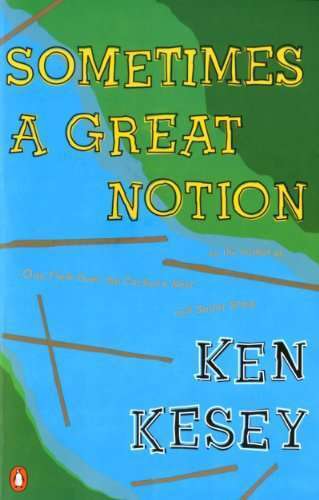
Ken Kesey’s Sometimes a Great Notion is the story of an independent logging family in Oregon facing pressure from the unions and the local community to join them in a strike against the timber mill. The Stamper clan, however, has a contract with the mill and intends to keep it come hell or high water—both of which have a role in the plot.
It’s a big, sprawling novel, but written at a time when novels meant something, before grad school aesthetes took over the publishing world and turned the novel into an “art form.” (It’s also available as a movie starring Paul Newman, at the link above.)
What makes Sometimes a Great Notion relevant today is that it accurately prophesied the division America would soon be going through between left and right, urban and rural, red states and blue states, Tea Party and Obamacare.
The strike and the Stamper clan’s refusal to join it forms the backdrop of the novel. The family motto is “Never give an inch,” and although the family patriarch Henry is laid up with a broken arm he still kicks everybody out of bed at 4:30 a.m. to get the day rolling. His son Hank, a crew-cut, former high school athlete and general all-American stud, runs the crew. He’s less bellicose than his dad, but a tree slaying machine in the woods. The family lives in a huge log house on a narrow peninsula that juts out into a broad and unruly river, a place that has to be constantly sandbagged and shored up against the tidal pull of the river.
Into this scene walks Henry’s other son, Hank’s half-brother Leland, who nobody had seen for the better part of a decade. Years before the novel starts, Leland’s mother, who couldn’t handle the life of a logger’s wife, decamped to the east coast, little Lee in tow, never to be heard from again.
Lee shows up as the prototypical east coast, hippie–scraggly hair, pot smoking, over-educated, ironic, fatalistic. He is at his wits end, after a botched suicide attempt, not looking for absolution, but answers, and maybe revenge. Given the strike and the defection of some of the Stamper’s crew, Lee is quickly gang-pressed into woods to help fill the contract.
Of course, tensions escalate, between Hank and Lee and between the union and the Stamper clan. Equipment is sabotaged and a low-intensity war erupts on all fronts, personal and political, in the Oregon woods. But it would give away too much of the plot to say more.
The ending, however, is as grisly and triumphant as anything in American literature, with echoes of Mark Twain—two 20th century Tom Sawyers riding a logjam down a Western river in defiance of everything that sought to destroy them.
What we see as obvious today, Kesey predicted in 1964: That a clash between individualism and collectivism was coming, and that the outcome would change America forever. If you’re a contractor or work in any kind of construction, logging, or mining, or work; if you work with your hands, or run your own business; if you’ve about had it with the government, or the union rules or the erosion of personal liberty and the rise of the welfare-surveillance state, this is a novel about you.
And you best lace up your boots tight. The ending isn’t pretty.












